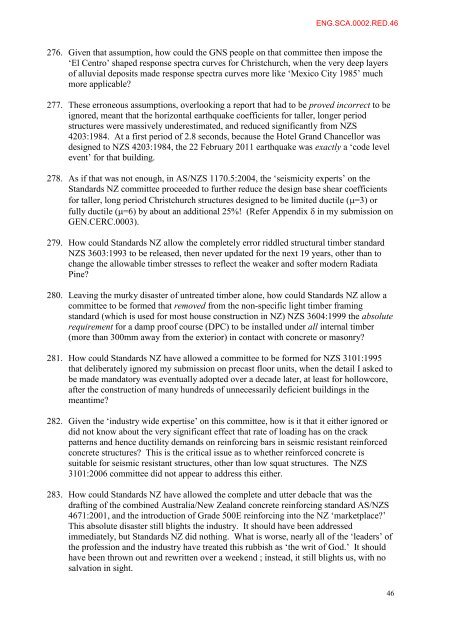John Scarry Engineering - Canterbury Earthquakes Royal ...
John Scarry Engineering - Canterbury Earthquakes Royal ...
John Scarry Engineering - Canterbury Earthquakes Royal ...
You also want an ePaper? Increase the reach of your titles
YUMPU automatically turns print PDFs into web optimized ePapers that Google loves.
ENG.SCA.0002.RED.46<br />
276. Given that assumption, how could the GNS people on that committee then impose the<br />
‘El Centro’ shaped response spectra curves for Christchurch, when the very deep layers<br />
of alluvial deposits made response spectra curves more like ‘Mexico City 1985’ much<br />
more applicable?<br />
277. These erroneous assumptions, overlooking a report that had to be proved incorrect to be<br />
ignored, meant that the horizontal earthquake coefficients for taller, longer period<br />
structures were massively underestimated, and reduced significantly from NZS<br />
4203:1984. At a first period of 2.8 seconds, because the Hotel Grand Chancellor was<br />
designed to NZS 4203:1984, the 22 February 2011 earthquake was exactly a ‘code level<br />
event’ for that building.<br />
278. As if that was not enough, in AS/NZS 1170.5:2004, the ‘seismicity experts’ on the<br />
Standards NZ committee proceeded to further reduce the design base shear coefficients<br />
for taller, long period Christchurch structures designed to be limited ductile (=3) or<br />
fully ductile (=6) by about an additional 25%! (Refer Appendix in my submission on<br />
GEN.CERC.0003).<br />
279. How could Standards NZ allow the completely error riddled structural timber standard<br />
NZS 3603:1993 to be released, then never updated for the next 19 years, other than to<br />
change the allowable timber stresses to reflect the weaker and softer modern Radiata<br />
Pine?<br />
280. Leaving the murky disaster of untreated timber alone, how could Standards NZ allow a<br />
committee to be formed that removed from the non-specific light timber framing<br />
standard (which is used for most house construction in NZ) NZS 3604:1999 the absolute<br />
requirement for a damp proof course (DPC) to be installed under all internal timber<br />
(more than 300mm away from the exterior) in contact with concrete or masonry?<br />
281. How could Standards NZ have allowed a committee to be formed for NZS 3101:1995<br />
that deliberately ignored my submission on precast floor units, when the detail I asked to<br />
be made mandatory was eventually adopted over a decade later, at least for hollowcore,<br />
after the construction of many hundreds of unnecessarily deficient buildings in the<br />
meantime?<br />
282. Given the ‘industry wide expertise’ on this committee, how is it that it either ignored or<br />
did not know about the very significant effect that rate of loading has on the crack<br />
patterns and hence ductility demands on reinforcing bars in seismic resistant reinforced<br />
concrete structures? This is the critical issue as to whether reinforced concrete is<br />
suitable for seismic resistant structures, other than low squat structures. The NZS<br />
3101:2006 committee did not appear to address this either.<br />
283. How could Standards NZ have allowed the complete and utter debacle that was the<br />
drafting of the combined Australia/New Zealand concrete reinforcing standard AS/NZS<br />
4671:2001, and the introduction of Grade 500E reinforcing into the NZ ‘marketplace?’<br />
This absolute disaster still blights the industry. It should have been addressed<br />
immediately, but Standards NZ did nothing. What is worse, nearly all of the ‘leaders’ of<br />
the profession and the industry have treated this rubbish as ‘the writ of God.’ It should<br />
have been thrown out and rewritten over a weekend ; instead, it still blights us, with no<br />
salvation in sight.<br />
46




